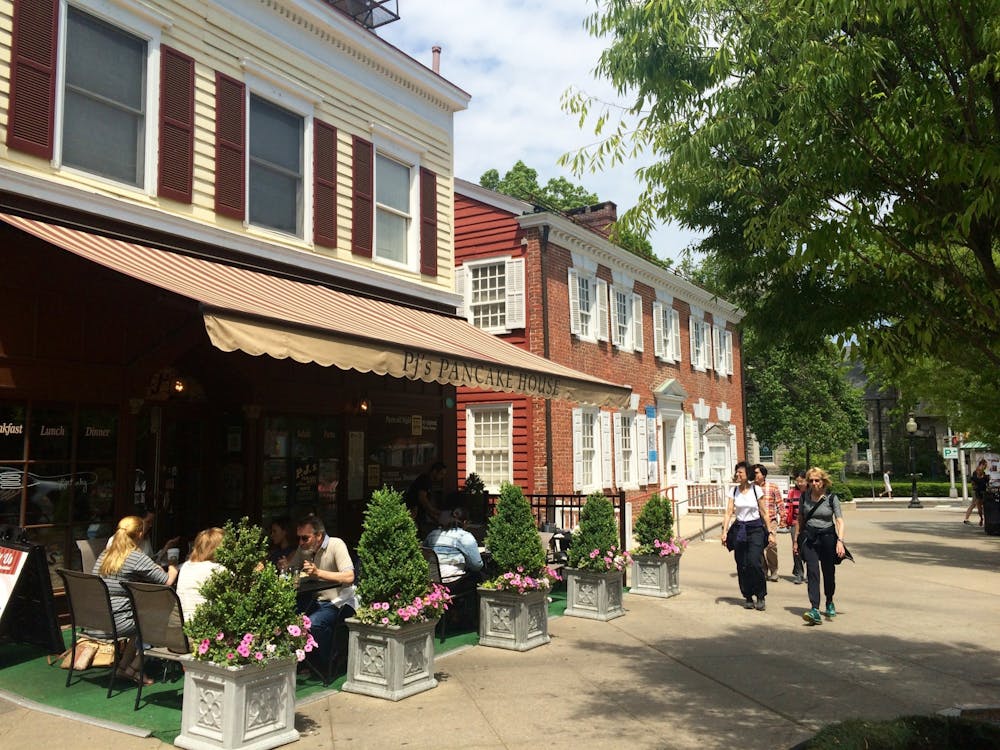Entering the "America Effect: Global Perspectives on the United States, 1990-2003," a new exhibit at the Whitney Museum, one immediately encounters a bright, gleaming portrait of New York City's Sept. 11th hero and former mayor Rudolph Giuliani.
The epic-sized image features Giuliani gazing outward optimistically in front of the New York City skyline. With a softened effect, the painting looks like a cheesy, airbrushed photograph – something hanging on the wall of a Glamour Shots studio. Beneath the portrait are two balls of elephant dung, an allusion to Giuliani's attempt in 1999 to censor an exhibit at the Brooklyn Museum that featured a painting of a black Madonna smeared with elephant droppings.
Although its composition is reminiscent of Giuliani's Time Magazine cover, the painting, titled "Libertas, Dei Te Serventi" by Chinese artist Zhou Tiehai, does not honor Giuliani but intensifies his heroic stance to the point of propaganda. Tiehai ironically employs Socialist Realism, the Communist genre of portrait painting used to glorify Stalin and Mao. Commenting on his efforts to control artistic freedom, Tiehai equates Giuliani, America's "great leader", with the world's most denounced tyrants.
With this unlikely comparison, "Libertas, Dei Te Serventi" sets the tone for the rest of the show.
The "American Effect" explores a wide range of global perceptions of the United States. The idea of Lawrence Rinder, the Whitney's curator of contemporary art, the "American Effect" contains works of all media — documentary films, videos, installations, photographs and paintings — from 30 countries on six continents.
As the wall text states: "Artists are expressing not only America's direct impact — the visible, physical consequences of its foreign policies, trade agreements, cultural exports and military activities — but also its psychological effects."
Although the exhibit presents a variety of reactions to the U.S., from hostile jeremiads to admiration, it is not surprising that the "American Effect" is overwhelmingly critical. What is disappointing is that the criticisms of all the obvious American evils — including consumerism, imperialism and racial inequality — are expected and rarely presented in a novel way. Yet, overall, the "American Effect" is entertaining, interesting and accessible to all audiences.
One of the most amusing installations is French artist Gilles Barbier's "Nursing Home" (2002) featuring life-sized sculptures of aged superheroes. Captain America lies on a stretcher attached to an IV. Catwoman, sagging and wrinkled, is asleep on an armchair in front of a TV playing old reruns. An elderly Superman hunches over his walker. These comic heroes were once, like the United States, indestructible. Is America past its prime as well?
"Ma McKinley" (2001) is a scathing criticism of U.S. involvement in the Philippines. The painting depicts an American mother with the face of President William McKinley holding a Filipino child. McKinley, in an attempt to "uplift, civilize and Christianize" the Filipinos, initiated a three year war with the Philippines through which America gained control of its territory. In the painting by Alfredo Esquillo, Ma McKinley has eagle-clawed hands and a gun protruding from her sleeve. The Filipino child is fashioned in a dress with an American flag design and wears a cross earring. One of the few positive reactions to America, Congoan artist Bodys Isek Kingelez's "New Manhattan 3021" imagines the New York of 3021 as a futuristic, flamboyant metropolis. Created in 2002, "New Manhattan" reflects Kingelez's faith in America's ability to rebuild, especially in the aftermath of Sept. 11th.
In one room of the exhibit there were several screens showing different short films. Bjørn Melhus filmed "America Sells" (1990) on the day of the unification of the German monetary system following the fall of the Berlin Wall.
The film dissects a performance of a troupe of American students in Berlin. It begins with a series of images of American products that have infiltrated German society — Mickey Mouse hats for sale, a Camel cigarette ad, the Pepsi logo, a Cadillac. These images set the stage for the themes of "America Sells" — the absurdity and rampant commercialism of America.
The students perform a ballad called "America Sings" with ridiculous lyrics like "America lives in the hearts of the people . . . America tries/ America hopes/ America cries."

Throughout the performance the students bounce around, wave flags and scream mindlessly. Melhus particularly underscores the absurdity of the performance by repeatedly replaying clips and using slow motion. Melhus also shows the students selling T-shirts after the performances and flashes phrases on the screen such as "very cheap," "feel free" and "buy T-shirts."
The short film "Last Road Trip" (2000) is an apocalyptic fantasy by Dutch artist Amo Coenen. Using the "great American road trip" as a vehicle, the digitally-animated film follows a psychedelic journey through Southern California with all the necessary vices — fast food, suicide, pornography and police chases.
In response to Makoto Aida's "A Picture of an Air Raid on New York City (War Picture Returns)" (1996), the wall text explains that the Japanese artist "is not in favor of attacking America." Yet "A Picture of an Air Raid" depicts Midtown New York in flames under the attack of Japanese World War II-era fighter planes. In retaliation for the devastation of Japan, Aida imagines the "horrors of war" in America and the justice of "the cycle of revenge."
With conflicting visions of American destruction and rejuvenation, few exhibits seem as timely as the Whitney's "American Effect."
The "America Effect: Global Perspectives on the United States, 1990-2003" is at the Whitney through Oct. 12th. Student tickets are $9.50 with Student ID, except on Friday nights when admission is "pay what you wish." The Whitney Museum of American Art is located at 945 Madison Avenue at 75th Street.







